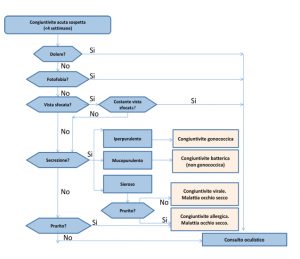The conjunctivitis is among the main causes of red eye.
L'red eye is caused by dilation of the blood vessels that supply the ocular tissues and is one of the most common ophthalmic problems.
If red eye is identified as a symptom of conjunctivitis, a specific approach is required to effectively treat this infection, which is one of the most common eye diseases and leads to frequent medical consultations, so much so that it accounts for about 70% of the patient's consultations with the ophthalmologist.
Aetiology and classification
The conjunctivitis is an inflammation of the conjunctiva, the thin, transparent, mucous membrane that lines the inside of the eyelids and, when folded, covers the front of the eyeball.
The different forms of conjunctivitis are characterised by inflammation of the superficial blood vessels of the conjunctiva, which irrigate the ocular surface. In most cases, cell infiltration and exudation are also present.
The aetiology of conjunctivitis can be infectious or non-infectious.
Virus e bacteria are the most common infectious causes, while non-infectious conjunctivitis is predominantly allergic.
Non-infectious conjunctivitis can also be of toxic, scarring or inflammation secondary to the presence of immune-mediated diseases and neoplastic processes.
Differential diagnosis
The correct distinction between the various types of conjunctivitis represents a major problem, as differential diagnosis is not simple but is essential to ensure the right treatment and rapid resolution of the condition without serious complications, such as loss of vision or structural damage to the eye.
Moreover, it is essential to set up the diagnostic procedure appropriately, differentiate conjunctivitis from other eye diseases as well who have a similar clinical picture.
The symptomatology of conjunctivitis can in fact conceal serious diseases such as acute glaucoma, blepharitis and keratitis.
A meta-analysis in 2003, analysed several studies in order to find a correlation between signs, symptoms and aetiology of conjunctivitis to facilitate its diagnosis, but no correlation was successfully highlighted as certain by the authors.
An algorithm for diagnosis and treatment
A useful approach for the diagnosis and treatment of conjunctivitis is to algorithmic which considers both the patient's ocular history and the results of the eye examination.
The algorithm gives indications of the type of conjunctivitis, based on the type of secretion and ocular symptoms, for example:
- one purulent or mucopurulent eye discharge is often related to bacterial conjunctivitis
- one watery secretion is more characteristic of viral conjunctivitis;
- the itching is, often, associated with allergic conjunctivitis.
Le causes underlying the onset of conjunctivitis are influenced by the age of the patient and the season of the year:
- the viral conjunctivitis are the most common infectious conjunctivitis, both overall and in the adult population, and occur predominantly in summer;
- the bacterial conjunctivitis are the second most common cause of infectious conjunctivitis and occur in 50%-75ven cases in children, they are also observed more frequently by December to April;
- the allergic conjunctivitis is the most frequent form of conjunctivitis, affecting 15% to 40% of the population and is most frequently observed in spring and summer.
Viral conjunctivitis
Viral conjunctivitis is, in most cases, caused by Adenovirus (90%) and is generally presented as bilateral, purulent with aqueous secretion and a small mucous component.
Symptoms include granularity, burning or irritation, and photophobia.
This type of eye infection is contagiousThe estimated transmission risk is between 10% and 50%, and is usually accompanied by respiratory symptoms. Adenovirus serotypes 8, 19, and 37 can be particularly fulminant due to variations in the host's immune factors and can lead to epidemics of keratoconjunctivitis.
Other viral causes include Herpes simplex (1.3%-4.8%), the infection of which is usually unilateral and associated with vesicular lesions of the lips (cold sores); Herpes zoster whose infection involves the first and second branches of the trigeminal nerve leading to potential corneal complications and uveitis. Other viral conjunctivitis is caused by Molluscum contagiosum which can lead to follicular conjunctivitis in association with eyelid lesions and can potentially lead to serious ocular complications.
Although there is no effective treatment for viral conjunctivitis, the use of eye drops can alleviate some symptoms. Topical or systemic antiviral drugs can be used to prevent corneal involvement. Artificial tears, topical antihistamines or cold compresses are also used to alleviate some of the symptoms.
Bacterial conjunctivitis
Bacterial conjunctivitis can be contracted directly from infected individuals or can result from dysbiosis of the normal conjunctival microbiome.
Contagion
The most common routes of transmission are hands, contaminated materials, and oculo-genital spread; in addition, certain conditions such as impaired tear production, disruption of the natural epithelial barrier, abnormality of adnexal structures, trauma, and an immunosuppressed state are predisposing factors for bacterial conjunctivitis.
Causes
In adults The most common pathogens causing conjunctivitis are bacteria of the species Staphylococcus, followed by Streptococcus pneumoniae e Haemophilus influenzae.
In childrendisease is most often caused by H.influenzae (29%), S.pneumoniae (20%) and Moraxella catarrhalis. This type of conjunctivitis, called bacterial conjunctivitis acute, initially arises unilaterally, however, the second eye is often affected soon afterwards. Symptoms are sticky muco-purulent discharge and a foreign body sensation in the eye; pupillary reactions or vision are not affected.
Bacterial conjunctivitis hyperacute is often given by Neisseria gonorrhoeae which spreads in sexually active adults while it can be acquired by infants at birth.
The infection has a sudden onset, and rapidly progresses to perforation of the cornea.
The pathology is characterised by a copious purulent discharge that reforms rapidly after it has been removed; symptoms are pain, decreased vision and preauricular lymphadenopathy.
Bacterial conjunctivitis chronic is characterised by signs and symptoms that persist, including swelling of the eyes. for at least four weeks, with frequent relapses.
Symptoms are red eye and persistent purulent discharge and is generally caused by Staphylococcus aureus, Moraxella lacunata and enteric bacteria.
In 60% of cases the most common acute bacterial conjunctivitis is self-limitingbut appropriate treatment can accelerate healing. within 1 to 2 weeks of onset.
The benefits of a antibiotic treatment However, they include a faster recovery and decreased transmissibilityThere are also no side effects if the antibiotics are used appropriately.
All broad-spectrum antibiotic eye drops appear, in general, to be effective in the treatment of acute bacterial conjunctivitis.
However, the inappropriate use of antimicrobials is associated with a increased bacterial resistanceand global action has been taken in recent years to reduce the prescription of antibiotics in unnecessary cases.

(modified from Azari and Barney, 2013)
Suggested algorithmic clinical approach for suspected acute conjunctivitis (modified from Azari and Barney, 2013)
In this sense a very recent research published in BMJ Open Ophthalmologyanalysed 8209 conjunctival swabs of which 15.8% were bacterial-positive, of these 75.2% were identified as Gram-positive. S. aureus was the predominantly identified microorganism. The researchers also evaluated the resistance of micro-organisms isolated acloramphenicol, ciprofloxacin, gentamicin and methicillin. The results of the study showed that, among the antibiotics analysed, chloramphenicol had the lowest resistance rate (8.4%) and resistance was predominantly related to Gram-negatives; whereas ciprofloxacin and gentamicin showed resistance rates of 16.4% and 14.0% respectively.
Seasonal allergic conjunctivitis
Seasonal allergic conjunctivitis (SAC) is caused by the inflammatory response of the conjunctiva to environmental allergens. Redness and itching are the most common symptoms, often associated with allergic rhinitistreatment consists of avoiding the triggering antigen as much as possible and using saline solutions or artificial tears to physically dilute the allergens and remove them from the eye.
Depending on the case, topical decongestants, antihistamines, mast cell stabilisers, non-steroidal anti-inflammatory drugs and corticosteroids may be indicated.
On the subject of conjunctivitis, see also:
- Netilmycin/dexamethasone in the treatment of conjunctivitis - Oculist Italiano
- Focus on conjunctivitis - Oculista Italiano
- Infectious Conjunctivitis and Diabetes - Oculista Italiano
- Amir A. Azari and Neal P. Barney. Conjunctivitis: A Systematic Review of Diagnosis and Treatment. JAMA. 2013 October 23; 310(16): 1721-1729. doi:10.1001/jama.2013.280318
- Silvester A, Neal T, Czanner G, et al. Adult bacterial conjunctivitis: resistance patterns over 12 years in patients attending a large primary eye care centre in the UK. BMJ Open Ophth. 2016. doi:10.1136/bmjophth-2016-000006
